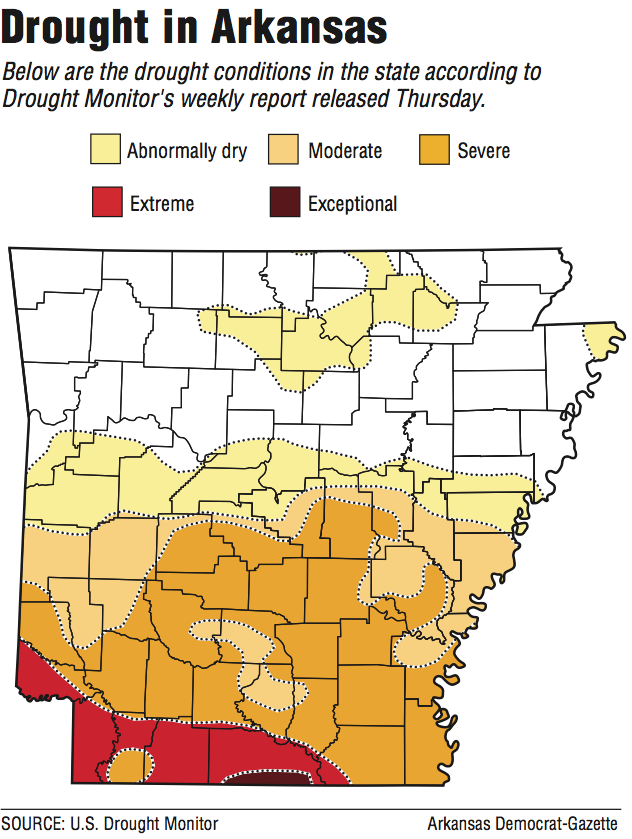Cattle farmers in south Arkansas are beginning to use hay normally reserved for winter months to feed livestock, and some are selling cows to reduce expenses as a quickly forming drought continues to grow in the state.
"We hadn't seen any measurable rain since the end of June," said Robin Bridges, a Union County extension agent for the University of Arkansas Division of Agriculture. "We're dry."
The National Drought Mitigation Center at the University of Nebraska-Lincoln said Thursday that 62.8 percent of Arkansas is in some form of drought, including a sliver in Union County that's considered in "exceptional" drought -- the worst classification. The designation is given to areas that have a deficit of 5 inches of rain over a 30-day period.
The southern half of the state is in drought, along with portions of 12 counties in north-central Arkansas and the extreme northeastern tip of Mississippi County.
The U.S. Department of Agriculture designated Bradley, Lafayette, Miller and Ouachita counties in the state as primary natural disaster areas due to the drought conditions. Ashley, Calhoun, Clark, Cleveland, Columbia, Dallas, Drew, Hempstead, Little River, Nevada and Union counties are also eligible to qualify for disaster assistance because they are contiguous.
David Miskus, a senior meteorologist for the National Oceanic and Atmospheric Administration's Climate Prediction Center in Washington, D.C., considered Arkansas' situation as a "short-term flash drought" because of its rapid formation. The state was drought-free 90 days ago, he said.
"Three months ago you had flooding in Oklahoma and Texas and along the Red River [in Arkansas]," he said. "Those floods wiped out any drought conditions. Then, what an incredible turn around."
Drought conditions also worsened in eastern Texas, northern Louisiana and central Alabama.
In Arkansas, the drought intensified during the week in the south-central part of the state with much of the area increasing from "moderate" drought last week to "severe" drought this week.
The "moderate" rating is given to areas with a deficit of 2 to 3 inches of rainfall over a 30-day period, and "severe" is designated for areas 3-4 inches short of rainfall during a 30-day period.
The state is trapped between two large stationary weather systems -- a ridge of high pressure over the southwestern United States and a system in the southeastern section of the country -- that either keeps rain-producing fronts to the north of Arkansas, or weakens them if they are able to push through.
The National Weather Service in North Little Rock said there is a 40 percent to 50 percent chance of rain in northeast Arkansas by late this afternoon, but chances of rain diminish as the system continues south.
"Whatever manages to fall will be soaked up by the ground," Weather Service meteorologist Charles Dalton of North Little Rock said. "Any showers will be hit-and-miss. There won't be any widespread, heavy rainfall."
After the front passes through, skies will remain clear for several days, and temperatures are expected to be in the 80s through at least late next week.
St. Francis County Judge Gary Hughes issued a burn ban for his county -- the 36th in the state to do so, and the first in the Delta.
"There doesn't appear to be any significant rainfall in the forecast," Hughes said. "We've had an increase in grass fires the last few weeks, and it's created havoc for our fire departments. We wanted to be safe.
"We were the first in my part of Arkansas to issue the ban," he said. "Somebody's got to be the first."
Bridges said Union County beef cattle raisers are beginning to use hay grown earlier this year and normally reserved for winter months to feed their herds.
"They made a tremendous amount of hay because of all the moisture earlier this year," Bridges said. "But it's early to begin using it now."
He said the dry conditions are also delaying farmers from planting pasture land for next year's hay crop.
"Farmers have to plan at least a season ahead," he said. "You can't predict the weather. That's why farming is the toughest of all industries -- because the weather plays such a role.
"Farmers naturally plant their winter hay in August or September. Now, they are looking at not getting their winter forage in until November or December."
State Desk on 10/09/2015
